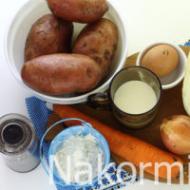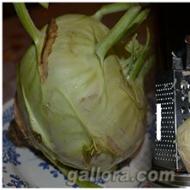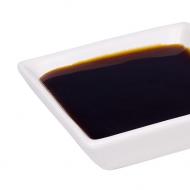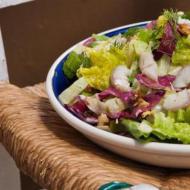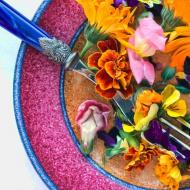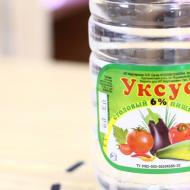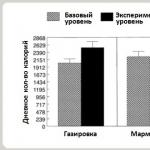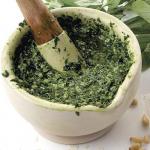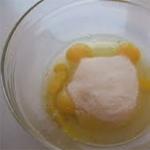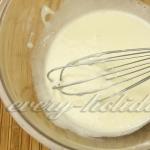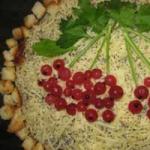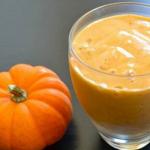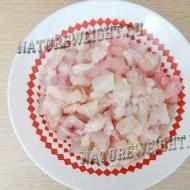
Cherry beer. Belgian cherry beer scream Description of cherry beer
If you are a beer fan and want to diversify your experience with an unexpected and absolutely amazing refreshing fruity aftertaste, we will undoubtedly recommend you the Belgian cherry beer Kriek.
Cherry beer Kriek is a variety of Belgian beer Lambic (Lambic), famous for its ancient brewing traditions. The name “Lambik” beer was inherited from the ancient Belgian city of Lembeek. And the word “Kriek” comes from the name of a variety of dark red cherry.
The recipe for making beer from cherries dates back to the times of the Crusades. Legend has it that a certain crusader, returning from a campaign, decided to brew beer reminiscent of the blood of Christ. To do this, he added dried cherries to the beer. Since then, the drink with the taste of cherry and a subtle aroma of almonds has become extremely popular in Belgium, and then throughout Europe.
According to ancient recipes, Belgian brewers still use dried cherries today, adding them to beer before fermentation. The proportion of cherry juice in beer is about 30%. The drink takes on a deep, rich color. Already brewed beer is aged for 2-3 months before reaching the table.
Relatively recently, another fruity variety of lambic was released in Belgium: a sunny-colored drink with a peach flavor and delicate aroma - “Lambic Peche”. By the way, if you use raspberries instead of cherries, the result is an excellent Belgian beer “Frambozen“.
When visiting our Belgian beer restaurant - the Lambic brasserie, be sure to order the Belgian cherry beer "Kriek".
You can try cherry beer “Kriek” in our Lambic brasserie. Our restaurants.
While most European breweries strictly respected beer traditions dating back to the Middle Ages, the Belgians missed opportunities to take liberties with the beer recipe.
It was here that famous fruit beers originated, including the legendary Belgian beer Kriek, known far beyond the borders of Belgium. In addition to cherries, which are the key element of this drink, the Belgians love to throw into the vat everything that grows outside the window: peaches, raspberries, apricots, nuts and other ingredients unusual for brewing, but cherry beer, of course, has become the national treasure of the inhabitants of Belgium.
History of the name
Belgian creek beer gets its name from the cherry variety of the same name, grown only near Brussels. According to documents found in the Belgian capital, this beer was first brewed during the Crusades, when one of the crusaders living in the Flemish village of Sherbuque tried to give the drink the color of blood, symbolizing the blood of Christ, and added the darkest cherry he could to the composition. find. The taste of cherry beer came as a surprise to everyone who tried it, and his recipe is a success to this day.
The secret of making beer scream
Classic Krik is a lambic to which fresh crushed Krik cherries are added at the rate of 100 kg of berries per 650 liters of drink. Cherries are added to beer when they are almost ripe. After this, they wait until the berries are completely dissolved (usually this takes from six months to 9 months), filter and clarify the resulting cry and bottle it, where it infuses for another year.
Perhaps the most famous Belgian beer is Timmermans Creek, which is famous for its characteristic cherry flavor, pleasant sourness of sherry, almond flavor and light hop aroma. It is drunk very cold: this way it perfectly quenches thirst and reveals its taste in the best way. Each of them considers it their duty to offer guests traditional Belgian creek, brewed according to an ancient recipe.
A unique recipe was found on the Internet cherry beer from San Sanych, which is prepared in the best brewing traditions. We have prepared step-by-step instructions and a video for you, where we will tell you in detail about the technology and processes that will occur with our beer during the brewing process.
For inexperienced brewers, the recipe will seem very complicated and lengthy, but in fact it is not much different from classic beer brewing. The only and very important difference is the preparation of cherry compote, on the basis of which our alcoholic drink will be made.

Ready to eat product
I suggest not to torment our readers and immediately post a video that shows the entire process of making cherry beer. San Sanych gives excellent comments, it is immediately clear that the person is very experienced in this matter.
Ingredients
Since everyone’s equipment for making beer has a different volume, it is not advisable to write any exact numbers. We offer a calculation made per 1 kilogram of malt:
- Cherry - 1 kg.
- Water - 4 liters.
- Yeast safbrew t58 - 0.7 grams per liter of wort.
- Alpha hops 5% - 1.4 grams per liter of wort.
- Dextrose (sugar) - 1 teaspoon per 0.5 liter of wort.
Making Cherry Beer
The whole process can be divided into three stages - cooking, removing sediment and adding yeast, as well as carbonation. I will highlight them all separately. You need to follow the instructions step by step, without missing anything.
Cooking (8 hours)

- Place all the cherries in a large container (without washing or pitting) and press intensively until they form a porridge. Pour the mixture into a cube.
- Pour in 60% of the total volume of water. Boil for 45 minutes. The base for the beer is ready.
- Filter the juice through a sieve and cool to 55 degrees.
- Pour all the malt into the juice and wait 10 minutes, during which time the temperature will drop to about 52 degrees.
- Slowly heat the wort to 63 degrees and maintain this temperature for 50 minutes.
- Heat to 72 degrees and wait 25 minutes.
- Heat to 78 degrees and wait 10 minutes.
- We filter the wort through a sieve, rinse the spent grain with the remaining 40% of water.
- Boil the resulting wort for 20 minutes and add 75% hops.
- Continue boiling for another 30 minutes and pour in the remaining 25% of the hops.
- Boil for another 10 minutes.
- Drain the wort through a sieve and cool for 14 hours.
Sediment and yeast (8 days)

- Remove the sediment once.
- Heat the wort to 30 degrees and pour in the yeast.
- Fermentation takes place during the week; keep the beer at room temperature.
- Remove the sediment 2 times.
- Cool the wort in the refrigerator for 24 hours and remove the sediment 3 times.
Carbonation (15 days)

- We calculate and add dextrose or sugar to our almost finished beer.
- We intensively disinfect the bottles with iodine solution or deochlor and dry them.
- Pour the beer into bottles and put it in a warm place for a day.
- Then keep the bottles at room temperature for a week.
- Once 7 days have passed, we put the bottles in the refrigerator for another week.
- The drink is ready to drink.
The process is quite labor-intensive and relatively long. It will take almost 24 days to brew the beer. But the result will be exceptionally good if you follow all the points in the recipe.

The drink has a rich color and foam
On San Sanych's channel you can ask him questions that interest you and get an answer. Or you can leave comments with us, and we will duplicate them under his video. Happy brewing!
A few years ago, no one in Russia had even heard of the fact that beer could be cherry. The only exceptions were some connoisseurs of the foamy drink. However, today Belgian cherry beer is freely available in most supermarkets. It stands out well with its bright label on the shelf of imported beer.
Belgian cherry beer is the most famous and widespread variety. In Belgium this variety is called "Kriek", which corresponds to the cherry variety, the berries of which are used to make beer. You can see the inscription “Kriek” on the bottle label of cherry beer.
There is a legend according to which the Belgian crusader, upon returning home, wished to prepare a drink the color of the blood of Jesus. He added cherry juice to ordinary beer, and that’s how the first Scream came out.
Video tasting of Belgian cherry beer St Louis Premium Kriek:
Real Creek, like all other varieties, Produced exclusively in Belgium, in the Senna River valley, using the natural spontaneous method. This is the only place in the world where the subspecies of wild yeast necessary for cooking lives. Therefore, something brewed in another country will not be real. In addition to yeast, Belgian beer may contain over eighty other microorganisms that enter the drink from the open air at the stage.
The preparation time for cherry can be up to two years. Usually cherry juice is added to the future beer before starting, but in some cases it can be pieces or whole berries that are completely fermented over time.
Cherry beer has a unique sweet taste and fruity aroma. Despite the high content, Kriek has absolutely no bitterness. The fact is that the one that is used for cooking is aged for several years to completely rid it of alpha acid. in this beer it is needed solely for quality. The alcohol content in beer, as a rule, does not exceed 5.5%.
 Cherry beer is sold in 330 ml glass bottles and bottles similar to champagne bottles. An excellent and original solution would be to purchase this beer instead of traditional champagne for a holiday. The beer is saturated with carbon dioxide and has persistent foam. Therefore, shooting the cork out of the bottle will not be a problem.
Cherry beer is sold in 330 ml glass bottles and bottles similar to champagne bottles. An excellent and original solution would be to purchase this beer instead of traditional champagne for a holiday. The beer is saturated with carbon dioxide and has persistent foam. Therefore, shooting the cork out of the bottle will not be a problem.
The main disadvantage of Belgian cherry beer is its price. A 330ml bottle will cost you about 130 rubles. But it’s worth trying it at least once anyway.
Kriek beer is a type of Belgian lambic, a spontaneously fermented wheat ale (brewers simply leave the barrels open to allow “wild” yeast to enter the wort). The name comes from the Flemish word kriek - "cherry".
Characteristics. The drink is produced on the basis of unmalted wheat (up to 40% mash) and pils malt. Hops are used to a minimum, and they are old and not bitter, only to provide better preservation to the beer. A characteristic feature of the style is the addition of sour cherries.
Krik has a sweet-sour flavor with a rich, fruity profile. Hop bitterness is most often completely absent; kriek beer most resembles a thick cherry compote with alcohol. This is a very aromatic and “fragrant” variety, the strength varies depending on the manufacturer and ranges from 3.5-8%.

Even the strongest brands are easy to drink, and intoxication occurs unnoticed. Fruit lambics are very drinkable, the alcohol has a slight warming effect, but never burns, does not “strike the throat,” and does not exhibit pronounced alcohol or fusel notes.
Kriek has a beautiful garnet-ruby color and forms a dense pink foam in the glass. In the bouquet you can feel not only the dominant cherry, but also notes of nuts (from the stone) and floral aromas. The older the drink, the more pronounced the lambic character is - nuances of old leather, barnyard, wet earth.
Historical reference
The history of Belgian lambics dates back to the Roman Empire. It is known that in the 1st century. AD Roman legionnaires in the territory of the modern kingdom of Belgium drank beer of spontaneous fermentation, however, the nuances of this historical style remain behind the scenes. The term “lambic” is already found in documents of the 16th century, and Emperor Charles V himself was one of the connoisseurs of this variety.
 Characteristic red foam
Characteristic red foam The creek style appeared in the commune of Schaarbeek, famous for its autochthonous cherries: sour, fleshy, with large stones. Nowadays, fruits suitable for Krik (mainly Morello varieties) are grown throughout Belgium and even in other countries. In addition, many manufacturers prefer sweeter varieties.
A beautiful (but unsubstantiated) legend says that Creek beer was invented by one particularly zealous crusader who wanted to get a drink similar to the blood of Christ.
Cooking technology
The classic cherry creek beer is made in the area around Brussels. As a basis, they take sour and dry lambic aged at least a year, soak slightly cut cherries in it, right with the pits (the berries make up up to 30% of the total volume), wait several months until all the additional sugar from the cherries is fermented. Classic technology does not involve adding sweeteners, but the original product is so tart and sour that many manufacturers still include sugar, cherry juice or syrup in the recipe.
 Morello - a variety of cherries for the classic cry
Morello - a variety of cherries for the classic cry After many months of maceration, the cherries are removed, the beer is filtered and blended. A real scream is always a combination of several portions of different ages.
Classic lambic (including fruit lambic) is produced by spontaneous fermentation - the brewer does not add yeast to the composition, but simply opens the lid on the barrel with wort and waits for microorganisms to get inside and activate fermentation. In commercial production, of course, craftsmen often “help” the drink.
A similar raspberry-based beer is called Framboise, but it is much less common outside of Belgium.
How to drink beer scream
Cherry beer is drunk from pot-bellied snifter glasses with a volume of 0.3 or 0.5 liters; it is also sometimes served in trapezoidal tall glasses, like Weissbier. Krik does not have to be eaten as a snack - without gastronomic accompaniment, the taste is better revealed, especially since modern sweetened varieties are quite high in calories. However, you can serve Krik beer with desserts, fruits, sorbets, light salads, and cheesecake. Some foodies suggest pairing Krik with goat cheese or even spicy Indian food.
 Savory creek is usually served with meat snacks with pickled cherries or cherry sauce
Savory creek is usually served with meat snacks with pickled cherries or cherry sauce Cherry beer, like other lambics, is cooled to approximately +8 °C before serving (a range of 4-12 degrees is acceptable). In general, Belgian fruit beer is often compared to champagne and when serving it is recommended to adhere to the same rules.
Famous brands
One of the most famous scream brands is Belle-Vue. This is a sweet beer, popular among ladies. This category also includes Lindemans, Chapeau, Timmermans, Mort Subite.
More traditional, sour screams – Boon, Cantillon, Girardin.
Some producers, trying to be original, produce krik based on Flemish brown ale instead of lambic. The brands Liefmans, Kasteel, and De Ryck are distinguished by such experiments.

